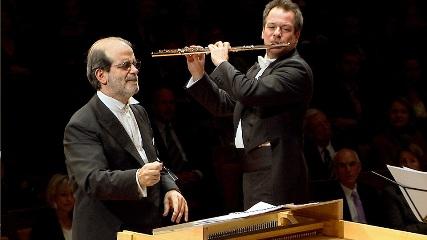In concert - Berliner Philharmoniker perform Vivaldi (2014)
In concert - Berliner Philharmoniker perform Vivaldi (2014)

I. Concerto for solo violin, two oboes, two horns, timpani, strings and continuo in D major RV 562a 0. Applause 1. I. Allegro 2. II. Grave 3. III. Allegro 4. Applause II. Concerto for solo violin, solo oboe, two recorders, two oboes, bassoon, strings and continuo in G minor RV 576 5. (without notification) 6. II. Larghetto 7. III. Allegro 8. Applause III. Concerto for transverse flute, strings and continuo in G minor RV 439 »La notte« 9. Concerto g-Moll, RV 439 10. Applause IV. Concerto for solo violin, solo cello, two oboes, two horns, bassoon, strings and continuo in F major RV 569 11. I. Allegro 12. II. Adagio 13. III. Allegro 14. Applause V. Gloria für Soli, Chor, Oboe und Orchester D-Dur, RV 589 15. I. Gloria 16. II. In terra pax 17. III. Laudamus Te 18. IV. Gratias Agimus Tibi 19. V. Propter Magnam Gloriam Tuam 20. VI. Domine Deus 21. VII. Domine Fili Unigenite 22. VIII. Domine Deus, Agnus Dei 23. IX. Qui Tollis Peccata Mundi 24. X. Qui Sedes Ad Dexteram Patris 25. XI. Quoniam Tu Solus Sanctus 26. XII. Cum Sancto Spiritu 27. Applause Andreas Buschatz, Violine [I., IV.] Anna Fusek - recorder [II.] Giulia Genini - Blockflöte - recorder [II.] Emmanuel Pahud - Traversflöte - flute [III.] Albrecht Mayer, Oboe [II., V.] Lisa Larsson, Sopran [V.] Marina Prudenskaja, Mezzosopran [V.] RIAS Kammerchor [V.] Berliner Philharmoniker Andrea Marcon - Cembalo und Leitung
Antonio Vivaldi, who refined Arcangelo Corelli’s concerto grosso with a palette of colours never before known to the “concerto con molti stromenti”, was already held in high esteem in Italy during his lifetime as a virtuoso, an experimental composer and a successful opera entrepreneur. An excellent opportunity to make his creative work known outside of the country came about in 1716, when Prince Elector Frederick August II of Saxony visited Venice together with several musicians from his Dresden court orchestra.
The orchestra was famous throughout Europe, and its concertmaster Johann Georg Pisendel became Vivaldi’s pupil and friend. He would later disseminate his music around the world via the Dresden “hub” – works like the Concerto for solo violin, solo violoncello, two oboes, two horns, bassoon, strings and basso continuo RV 569 and the Concerto in G minor for solo violin, solo oboe, two recorders, two oboes, bassoon, strings and basso continuo RV 576, which originated exclusively for the Dresden ensemble of virtuosi.
That Vivaldi not only broke new ground with more fully scored solo concerti became known only at the end of the 1930’s when an extensive collection of vocal works was rediscovered that by that time had fallen into oblivion. The Gloria in D major was probably the most significant sacred choral work of the Venetian master – a brilliant composition with alto and soprano soli, composed for a performance at Vivaldi’s sphere of activity for many years, the Ospedale della Pietà.
With these concerts, the Berliner Philharmoniker prove yet again in this season that historically informed practice has long since found its way into modern symphony orchestras; for this, they have invited the Italian baroque specialist Andrea Marcon to conduct them. --- berliner-philharmoniker.de
uploaded yandex 4shared mediafire mega solidfiles cloudmailru filecloudio anonfiles oboom








